Freight Shipping between the US and Europe | Rates – Transit Times – Duties & Taxes
You are looking to import products between the United States and Europe? This is just for you.
For companies involved in international commerce between the United States and Europe, understanding the intricacies of freight shipping is essential. This article explores the key aspects of shipping goods across the Atlantic, providing valuable insights into freight rates, transit times, and the complexities of duties and taxes that businesses must navigate between the United States and Europe.
Whether you are a seasoned importer/exporter or a budding entrepreneur exploring international trade opportunities, you will be fully equipped with the necessary knowledge to thrive in the dynamic world of transatlantic freight shipping.
What is the best method of transport between the US and Europe
The best method of transport between the US and Europe largely depends on the specific needs and requirements of the shipment, as well as factors such as cost, transit time, and the nature of the goods being transported.
- Ocean freight is often the most economical option for transporting large quantities of goods between the US and Europe. It is suitable for non-perishable items or goods with longer lead times. Container ships are the primary means of transport, and while the transit time is longer compared to air freight, it offers a cost-effective solution for bulk shipments
- Air freight is the preferred choice when speed is a top priority and time-sensitive goods need to be transported,It is faster than ocean freight, making it suitable for perishable goods, high-value items, or urgent shipments. However, air freight is generally more expensive, so it is frequently reserved for shipments with specific time constraints.
Intermodal transport combines different modes of transportation, such as using trucks, trains, and ships, to optimize the shipment’s efficiency and cost-effectiveness. It can provide a seamless door-to-door delivery service, leveraging the benefits of each transport mode.
Docshipper Note:
Need assistance with your shipment? Dont hesitate to contact us even for a simple question. Choose the option that suits you
Live chat with an expert Chat us on WhatsApp Fill the formNote DocShipper :
How can DocShipper help?
Transporting goods from China to Thailand? Simplify your journey with DocShipper! We handle everything, from organizing the transport to ensuring smooth customs procedures. Enjoy hassle-free logistics allowing you to focus on what really matters – your business. Need a hand? Reach out for a free quote in 24 hours or dial our consultants for free advice.

Ocean freight shipping between the US and Europe
Ocean shipping between the United States and Europe is a critical component of the global trade network, facilitating the movement of goods and fostering economic ties between these two major regions. The shipping relationship between the US and Europe is characterized by a long history of trade, well-established maritime routes, and a substantial volume of cargo exchanged annually.
Historically, in terms of agreement, the United States and the European Union (EU) have a Short Sea Shipping agreement to promote sustainable and competitive freight and passenger transport.
The biggest shipping ports in Europe
- Rotterdam Port (Netherlands)
The Port of Rotterdam is The biggest and most important seaport in Europe. The Rhine-Meuse delta’s port is situated on the North Sea. It served as the world’s busiest port from the 1960s through 1986.
It can accommodate the largest ships in the world, as the maximum draft in the port is 24 meters.
In 2022, the Port of Rotterdam annual throughput was 14.4 million TEUs.
- Port of Antwerp (Belgium)
The Port of Antwerp is one of the ports in North-West Europe that is expanding the quickest. Over 150,000 people are employed there, and it has a 13,000 ha area. With a capacity of more than 20,000 TEUs after modernization, the port can accommodate the largest ships in the world. The ports of Antwerp and Bruges combined in 2022.
It has one of the best locations in the center of Europe to transship goods.
In 2022, the Port of Antwerp annual throughput was 13.4 million TEUs.
- Port of Hamburg (Germany)
The Port of Hamburg is the biggest port in Germany. Founded on May 7, 1189, it is frequently referred to as the “gateway to the world.” The fact that all container terminals have integrated railroad terminals, improves the port’s standing in Europe.
In 2022, the Port of Hamburg annual throughput was 8.2 million TEUs.
- Port of Valencia (Spain)
One of the biggest seaports in the Mediterranean is Valencia’s port. More than 7,500 ships a year use this port, which employs over 15,000 people. In a 350 km radius, the port of Valencia serves as the hub of commercial activity.
In 20222, the Port of Valencia annual throughput was 5 million TEUs.
- Port of Piraeus (Greece)
The largest port in Greece is Piraeus, close to Athens, the capital. It mostly belonged to the Chinese COSCO. The port has three terminals with a combined capacity of more than 8 million TEU.
In 2022, the Port of Piraeus annual throughput was 5 million TEUs.
- Port of Algeciras (Spain)
The largest port in Spain (in Andalusia) and one of the biggest ports in Europe is Algeciras. The Port authority is the Port of Algeciras Bay Authority (APBA). APM Terminals Algeciras and Total Terminal International Algeciras, both with maximum drafts of 17.5–18.5 meters, are the port’s two container terminals.
In 2022, the Port of Algeciras annual throughput was 4.7 million TEUs.
The biggest shipping ports in the US
- Port of Los Angeles, California
The Port of Los Angeles is located in the San Pedro Bay of the western US state of California. Given it’s strategic location, it’s responsible for the majority of the Transpacific trade. In 2021, it handled over 9 million TEUs (twenty-foot equivalent units) of containerized cargo annually.
- Port of Long beach, California
Right after Los Angeles, there’s the Port of Long Beach. Together with the Port of Los Angeles, they’re responsible for over one quarter of the total container trade in North America. Shipping containers to/from Long Beach is extremely popular as it is considered as one of the major gateways for trade with Asia.
The second-largest port in the United States and also one of the busiest globally, handling in 2021 over 8 million TEUs of containerized cargo annually.
On the Eastern coast, there’s the Port of New York and New Jersey. It’s the largest and busiest US east coast port and the nation’s third-largest. It offers access to one of the most concentrated consumer markets in the world, handling in 2021 over 7 million TEUs of containerized cargo annually.
- Port of Houston, Texas
In terms of foreign tonnage, the Port of Houston is the busiest port in the US and the largest on the Gulf Coast. Located in the fourth-largest state, it stretches 25 miles (ca. 40 km) and is just a few hours away from the Gulf of Mexico.
In 2021, it handled over 2 million TEUs of containerized cargo annually.
Transit time between the US and Europe
The sea freight shipping time is between 13 and 30 days from the US to European ports.
| Ports | Rotterdam | Antwerp | Hamburg | Valencia | Piraeus | Algeciras |
| Los Angeles | 30 | 30 | 30 | 29 | 33 | 28 |
| Long Beach | 30 | 30 | 30 | 29 | 33 | 28 |
| New York and New Jersey | 25 | 15 | 30 | 16 | 20 | 15 |
| Houston | 20 | 13 | 21 | 21 | 24 | 20 |
Types of containers
There are three types of standard sizes’ container often used by importers. All of them can be used for both leisure and business travel.
- The High Cube at 40 feet, which can hold 76 cubic meters.
- The forty-foot container, which can hold 67 cubic meters of material
- 20-foot container with a 33 cubic meter capacity
DocShipper Advice :
You have an upcoming shipment and would want to rely on us and gain from our industry experience? We can manage various logistical processes, such maritime freight, as an international freight forwarder. Contact our experts using the form on our website to acquire a free quote within 24 hours. you have an impending cargo and would want to rely on us and gain from our industry experience.
LCL: Less than Container Load
Less Than Container Load (LCL) refers to a shipping method where the goods of multiple shippers are consolidated into a single container for transportation. This is typically used when a shipper does not have enough cargo to fill an entire standard-sized container (usually a 20-foot or 40-foot container)
FCL: Full Container Load
Full Container Load (FCL) refers to a shipping method where a single shipper loads their goods into an entire container for shipment. In this method, the entire container is exclusively used by one shipper and their cargo. The shipper pays the full cost of renting the entire container, regardless of whether it is fully loaded or not.
Advantages of LCL
- Cost-Effective for Small Shipments: Businesses with smaller quantities of goods can benefit from LCL as they don’t have to pay for an entire container but only for the space they use, reducing shipping costs.
- Flexibility: LCL allows for more flexibility in shipping, especially for businesses with irregular or smaller shipment volumes.
Disadvantages of LCL
- Longer Transit Times: Since LCL involves consolidation and deconsolidation at both ends, it may result in longer transit times compared to FCL.
- Risk of Damage: With multiple shipments packed together, there is a slightly higher risk of damage or loss, although containerization helps minimize this risk.
Advantages of FCL
- Faster Transit Times: FCL shipments usually have faster transit times as there is no need for consolidation or deconsolidation at the ports.
- Lower Risk of Damage: Since the container is filled with a single shipper’s cargo, there is a lower risk of damage or loss during transit.
Disadvantages of FCL
- Higher Costs for Small Shipments: FCL can be cost-effective for larger shipments but might be more expensive for businesses with smaller quantities of goods, as they have to pay for the entire container space.
The choice between LCL and FCL will depend on the volume of goods being shipped, the cost considerations, and the urgency of the shipment. LCL is often more suitable for smaller shipments, while FCL is preferred for larger, more substantial shipments.
Special sea freight between the US and Europe
- Refrigerated or Temperature-Controlled
This service is designed for transporting perishable goods and sensitive products that require specific temperature conditions. It ensures that items like fresh produce, pharmaceuticals, and certain chemicals maintain their quality and integrity during transit.
- Roll-on/Roll-off (RoRo)
RoRo vessels are specialized ships designed to carry wheeled cargo, such as automobiles, trucks, buses, and construction equipment. This method is efficient and secure, allowing vehicles to be driven directly onto the ship for transportation.
- Breakbulk
Breakbulk shipping is ideal for goods that are too large, heavy, or irregularly shaped to fit into standard containers. It involves loading individual pieces of cargo directly onto the ship’s deck, and it caters to items like machinery, industrial equipment, and oversized components.
- Project Cargo
Project cargo refers to transporting complex and large-scale industrial equipment or machinery for specific projects. This service involves careful planning, engineering, and coordination to handle and ship these specialized cargoes.
How much does it cost to ship between the US and Europe
Shipping between the US and Europe can be very expensive. It’s very important for you to know the weight and volume of your products, since it’s usually based on that.
For example, to ship a 20ft container (FCL) from the Port of Los Angeles to the Port of Rotterdam, the price varies between $2100 and $3250 USD.
For a 40ft container (FCL) the price is between $2900 and $4000 USD.
However, maritime freight rates might change depending on a number of variables, including fuel costs, consumer demand, and seasonal variations. Therefore, it is advised to get in touch with many service providers to compare prices and bargain for the best deal for your particular shipping requirements, don’t hesitate to chat with an expert or fill out our form for a free shipping quote.
Air freight between the United States and Europe
Air freight between the US and Europe is very common. There is no doubt that both maritime and aviation traffic pass through the United States.
Air freight is frequently chosen over sea freight when only a few things need to be transported. In fact, because your product must share a container with other deliveries, there are extra expenses related to shipping modest quantities by sea, such as bundling and unbundling fees at the port. Because of this, we advise using air delivery if your shipment isn’t exactly 3 m3.
Classic vs. Express Air freight
There are two different options to ship your items by air:
- Using the space on scheduled commercial flights offered by airlines like American Airlines, Air China, Cathay Pacific, and Emirates, classic airfreight will load your cargo.
- The networks of “courier companies” that provide door-to-door services, such DHL, FedEx, TNT, and UPS, operate express airfreight. Express delivery is a quick and practical choice for sending small products or important papers across international borders.
Major airports in the US
(ATL) Hartsfield-Jackson Atlanta International Airport – Atlanta, Georgia
(LAX) Los Angeles International Airport – Los Angeles, California
(ORD) O’Hare International Airport – Chicago, Illinois
(DFW) Dallas/Fort Worth International Airport – Dallas, Texas
(DEN) Denver International Airport – Denver, Colorado
(JFK) John F. Kennedy International Airport – New York City, New York
Major airports in Europe
Paris Charles de Gaulle Airport – France
Amsterdam Airport Schiphol – Netherlands
Frankfurt Airport – Germany
Adolfo Suárez Madrid–Barajas Airport – Spain
Barcelona–El Prat Josep Tarradellas Airport – Spain
Leonardo da Vinci–Fiumicino Airport – Rome, Italy
Advantages of air freight
- One of the most significant advantages of air freight is its speed. Air shipments are much faster compared to other modes of transportation, such as sea or road. This makes it an ideal choice for time-sensitive goods, perishable items, and urgent deliveries.
- Then we have the reliable transit times. Airlines typically adhere to strict schedules, providing a high level of reliability for air freight shipments. This predictability is crucial for businesses that need to meet tight production schedules or ensure on-time delivery to customers.
- Air freight allows goods to be transported to virtually any location with an airport, making it an excellent choice for international trade. It connects businesses to markets worldwide and facilitates the movement of goods across borders efficiently.
Disadvantages of air freight
- One of the most significant disadvantages of air freight is its higher cost compared to other modes of transportation, such as sea or rail. The speed and convenience of air transport come with a premium price tag, making it less cost-effective for certain types of cargo, especially larger or heavier shipments.
- Airplanes have limited cargo space compared to ships or trains, making it challenging to accommodate oversized or bulky goods. Air freight may not be the best option for certain types of cargo that require larger containers or specialized handling.
- Air freight is one of the least environmentally friendly modes of transportation due to its higher fuel consumption and carbon emissions per unit of cargo transported. While advancements in fuel efficiency are being made, air transport still has a more significant environmental impact compared to other transportation options.
How much does air freight cost between the US and Australia
Shipping costs between the US and Europe depends on many factors including Weight and Volume of the shipment, Freight class or even the Airline chosen.
For example, prior to COVID-19, the cost of international air freight normally varied between $2.50 and $5.00 per kilogram, depending on the cargo and available space. When COVID-19 started a period of severe interruptions in maritime freight and consumer demand in February 2020, costs increased significantly, with air cargo rates hitting a range of $4.00–$8.00 per kilogram. Prices have decreased to about $3–$7 per kilogram as of the beginning of 2023, but they are still higher than they were before the epidemic, most likely as a result of rising labor and gasoline costs.
How to calculate the volumetric weight of your shipment
To calculate the volumetric weight of your shipment, you need to consider the dimensions of the package and the volumetric weight factor used by the shipping company.
Volumetric weight is often used by carriers to determine shipping costs when the actual weight of the package is lower than its dimensional weight.
- For Classic airfreight: 1 CBM = 167 kg
- For Express airfreight = 1 CBM = 200 kg
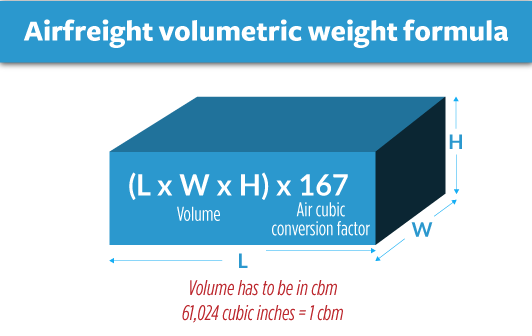
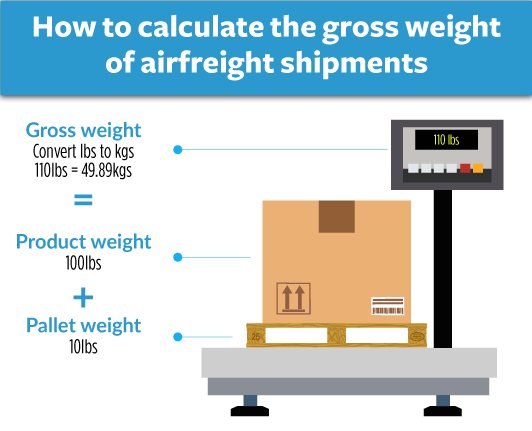
Important: Once your volumetric weight has been established to calculate the price of your cargo, it should be noted that airlines and airports apply additional fees and taxes.
DocShipper Tip:
Air freight might be the best solution for you if:
- You are in a hurry or have a strict deadline requirement, as air freight offers the fastest transit times.
- Your cargo is less than 2 CBM (Cubic Meter), making it more suitable for smaller shipments.
- Your shipment needs to reach a destination that is not easily accessible by sea or rail, allowing you to tap into the extensive network of global airports.

Door-to-door delivery between the US and Europe
Do you want the safe transportation of your goods? Door-to-door delivery is a premium service that includes everything from supplier pickup through delivery to your house or warehouse.
Relax and enjoy one of the specialty of DocShipper and let us take care of your logistical needs. We handle every step of the process.
Why is door-to-door service useful?
Door-to-door service is useful for several reasons, offering numerous benefits to businesses and individuals engaged in shipping and logistics.
- Eliminates the need for multiple intermediaries and simplifies the logistics process, as a single shipping company handles the entire transportation journey
- fewer handoffs and transitions between different transportation modes, which can lead to faster transit times
- You can avoid the complexities and paperwork associated with managing multiple shipping arrangements
Click here to look at our page about door-to-door delivery service, or don’t hesitate to directly fill in our form.

Customs clearance between the US and Europe
When importing into the USA, you need to understand that the US’ customs clearance procedure is a must. Customs clearance in the USA is overseen by the United States Customs and Border Protection (CBP), its primary border control organization.
As for Europe, it’s supervised by the European commission.
What you’ll need to provide:
- A commercial Invoice
- Packing List
- Bill of Lading
- An Airway Bill for Air freight
- Entry manifest
For the United States, The customs duties can be found in the US tariff system Harmonized Tariff Schedule, HTS for short.
For Europe, you can check the duty rates in the tariff systems: TARIC, which is the integrated Tariff of the European Communities and applicable in the Member State of destination.
Customs duty
The amount of customs tax that must be paid on imports to both the US and Europe depends on a number of factors. It includes the kind of goods being brought in, the country of origin, and the cost of the finished goods.
The USA’s average customs tariff is 3.4%, which is one of the lowest in the world. Tariffs usually depend on the origin of the product.
For Europe, it’s totally different. When importing, you don’t have to only pay customs duties, you have to pay Value-Added Tax (VAT) standing between 17% and 27% depending on the European countries. There are some other taxes like excise duties which are basically indirect taxes on the consumption or use of certain products (alcoholic beverages, mineral oils and manufactured tobacco).
Where to look up for your HS code for your products
The quickest way to find out your products’ HTS code is to ask your supplier for it. In fact, he is more likely to be familiar with the HTS code if they are used to selling their products for export.
By simply typing a term, like “pineapple” in our example, you may also use the “Harmonized System” to search any nation’s tariff database.
Another alternative is possible, you can also find your HS code by going to this website and typing the name of your product.
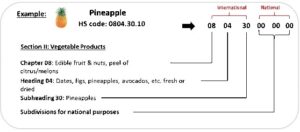
Calculate applicable tariff with your HS code
You located your HS Code, right? Now is the moment to determine how much tax your cargo will be subject to. Just follow these simple instructions:
Visit the Free Trade Agreement Portal European Union link to get to the following page:
We will examine this in conjunction with European website customs as follows:
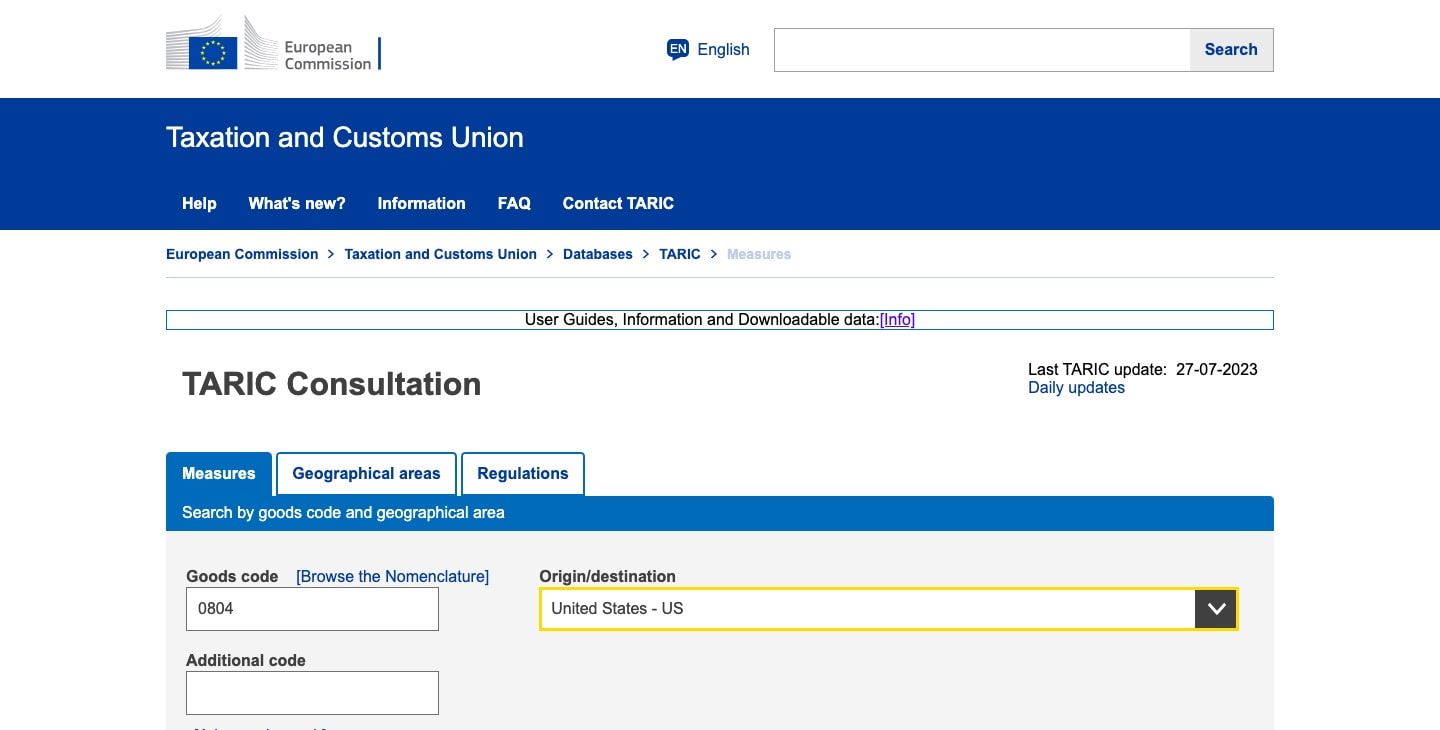
As for our example, you will have to fill in two things:
- Your HS code
- Origin of goods
Check the duties and taxes applied to your product
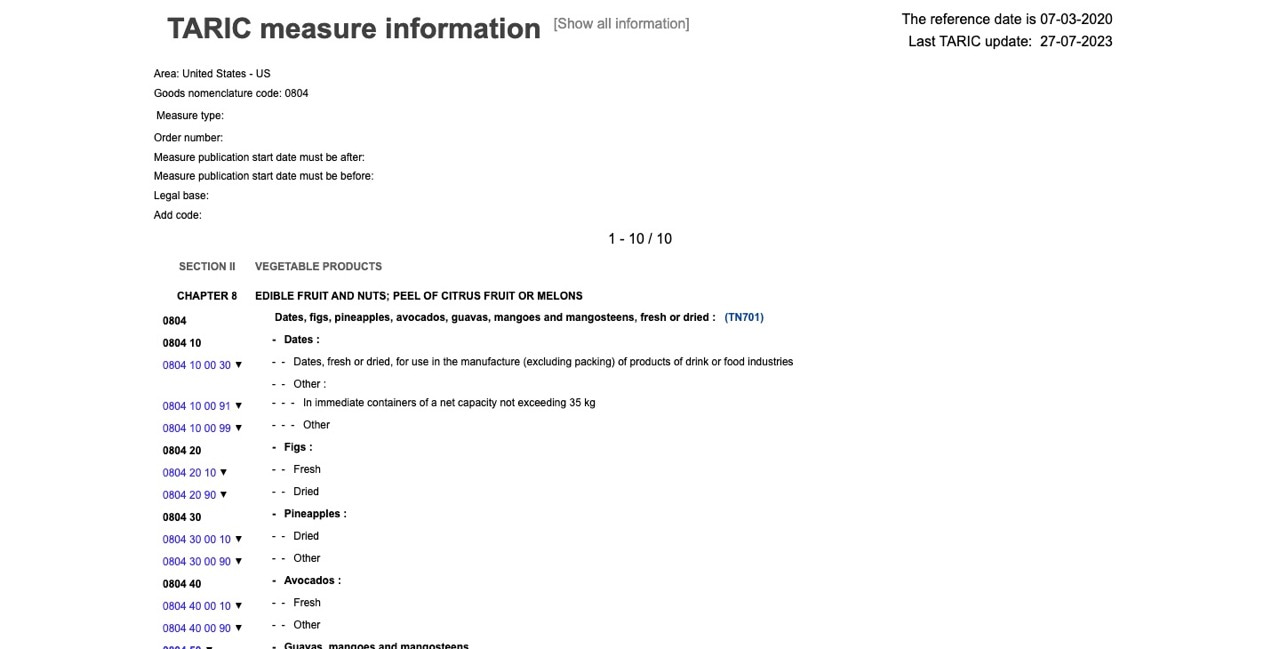
Does Docshipper charge duty?
You won’t pay anything if you work with our customs broker. We will come back with the papers produced by US or European customs, so you can confirm it.
Make a distinction between the fees DocShipper (or any other freight forwarder) will charge for customs clearance.
Customs clearance refers to the process of putting together a declaration file and the fees related to the declaration itself.
Customs clearing fees will be paid to DocShipper, while taxes and duties will be paid to the government.
Customs Procedures and Contacts
Europe Customs
 Official name: European Commission
Official name: European Commission
DocShipper Advice:
As you can see, Docshipper is far from being just an international forwarder. In fact, we take care of many other logistics operations such as customs clearance, or even packing and insurance! For more information, contact our experts via our form or directly by phone, you will receive a free quote within 24 hours.
Required documents for customs clearance
In addition to an HTS code, you’ll need a few other documents to clear customs with your imports.
- Commercial Invoice
This is the invoice that your supplier gave you when you made a purchase. This document must include the names of the buyer and seller, the type of goods, and the price you paid for them. For your items to be cleared by customs, you will require the original invoice. Verify that the packing list and the original invoice are identical.
- Bill of Lading
Document issued by the carrier. It attests that the exporter provided the items that were specified. It is a contract that details the specifics of an agreement between a shipper and a transportation firm and confirms receipt of the goods. Furthermore, it designates the type of cargo that will be transported between certain locations at a certain cost. The most fundamental document used in the transportation of goods serves as the goods’ title, contract of carriage, and receipt. On forms provided by the carrier, the shipper prepares it.
This could be an airway bill (AWB) for airborne cargo.
- Packing list
A document filled out by the shipper outlining the contents of the shipment. It includes the weight (gross and net), measurements, contents, and the numbering of each package in the shipment, as well as any distinctive characteristics (such as serial numbers), must be included. The buyer only pays duty on what they really received; it can also be used to spot things that are damaged or missing.
- Certificate of origin
A Certificate of Origin (CO) is a document used in international trade that historically identifies the country of origin of the goods transported. However, the term “origin” in a CO refers to the place where the items are actually created, not the location from which they are shipped. The CO’s function is to verify the country of origin of the sent products. This certificate certifies that the products being exported were truly produced in one of the nations listed on the certificate. If you want to take advantage of preferential rates of duty on particular products, this is crucial.
- Restricted and prohibited products
The importing of some goods into the US is restricted. Without prior approval from the FDA (Food and Drug Administration) or the USDA (US Department of Agriculture), other food products, whether made of animal or vegetable sources, are not permitted to enter the United States.
Similar restrictions on the importation of drugs, alcohol, firearms, and other items apply.
Restricted and prohibited products to import to the US
| Restricted | Prohibited |
|
|
Restricted and prohibited products to import to Europe
| Restricted | Prohibited |
|
|
Your Next Step with DocShipper
Additional logistics services
Discover DocShipper's holistic approach to supply chain management, covering not just shipping and customs, but a full suite of additional logistics services tailored to streamline your global operations effectively.
Warehousing and storage
Securing a reliable warehouse in a foreign land could be a mountain to climb. Your goods, especially temperature-sensitive ones, need perfect conditions to stay market-ready. Imagine the peace of mind that a well-managed, temperature-controlled storage would bring! Your quest for such reliable warehousing ends here. More info on our dedicated page: Warehousing.
Packaging and repackaging
Protecting your products for the journey from China to Thailand requires expert packing and repackaging. Looking for items that defy the odds? Our network of trustworthy agents can handle everything from electronics to fragile ceramics. They ensure safe transport, perfect for businesses shipping diverse goods. Want to dive deeper? Find more at our dedicated page: Freight Packaging

Cargo insurance
Cargo insurance acts as your safety net during your shipping journey. Ever considered a scenario where your shipment gets damaged by incidents other than fire? This is where cargo insurance comes into play, covering physical losses or damages from external causes. Think of a heavy storm tossing your ocean freight; cargo insurance has your back! Our customized coverage mitigates such risks. Need more insights? Visit our dedicated page: Cargo Insurance.
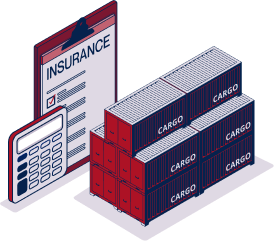
Supplier Management (Sourcing)
Looking to manufacture in Asia or East Europe? The supplier management service from DocShipper seamlessly handles it all - right from finding reliable suppliers to overseeing the entire procurement process. Forget language limitations or complex sourcing steps - DocShipper guides you through it all. For instance, if you strive to create a new toy line in China, we connect you with the best manufacturers and handle all purchasing details. More info on our dedicated page: Sourcing services
Personal effects shipping
Moving special items from China to Thailand? Your precious or oversized belongings deserve safe and efficient shipping. That's where we come in, with expertise in handling fragile and bulky cargo with utmost care. Consider the time we secured a customer's antique Chinese vase; it arrived in Bangkok unscathed! Craving more insights? More info on our dedicated page: Shipping Personal Belongings.
Quality Control
Ensuring the excellence of your products is our priority. Our Quality Control service eliminates your worries over manufacturing errors in your China-to-Thailand shipping. Imagine unboxing your Thai order only to find unsuitable items - a nightmare avoided with our pre-shipment inspection. Don't gamble with your business reputation; let us protect it. More info on our dedicated page: Quality Inspection
Product compliance services
Ensuring your merchandise arrives safely is essential, but have you considered if it meets local compliance standards? Our Product Compliance Services handle this crucial aspect, conducting rigorous laboratory tests for certification and verifying that your goods abide by the destination's regulations. Suppose true peace of mind in international shipping means no surprises at customs. In that case, our specialized expertise might be invaluable to you. More info on our dedicated page: Product compliance services
FAQ - Freight Shipping between the US and Europe
When shipping freight between the US and Europe, important factors to consider are shipping rates, transit times, and the applicable duties and taxes for the goods.
Businesses can determine the applicable duties and taxes for their freight shipments between the US and Europe by consulting customs authorities or working with experienced freight forwarders who can provide accurate information based on the goods' classification and destination country.
DocShipper leverages its expertise in freight forwarding and logistics to find the most cost-effective shipping solutions for businesses shipping between the US and Europe. They analyze various factors such as shipping routes, transportation modes, and cargo volumes to minimize shipping expenses.
While we don't require you to pay for insurance when importing goods to South Korea, it's something we strongly recommend. Shipping goods, whether nationally or internationally, can sometimes be a volatile venture, with incidents such as damage, loss, or theft occurring. Insurance is your safety net, ensuring that in the unfortunate case of such incidents, you have a fallback. It's all about securing your investment and providing peace of mind during the transit of your goods.
DocShipper has experienced customs brokers who are well-versed in the customs regulations of both the US and European countries. They can efficiently manage customs clearance procedures, ensuring compliance and minimizing delays.






